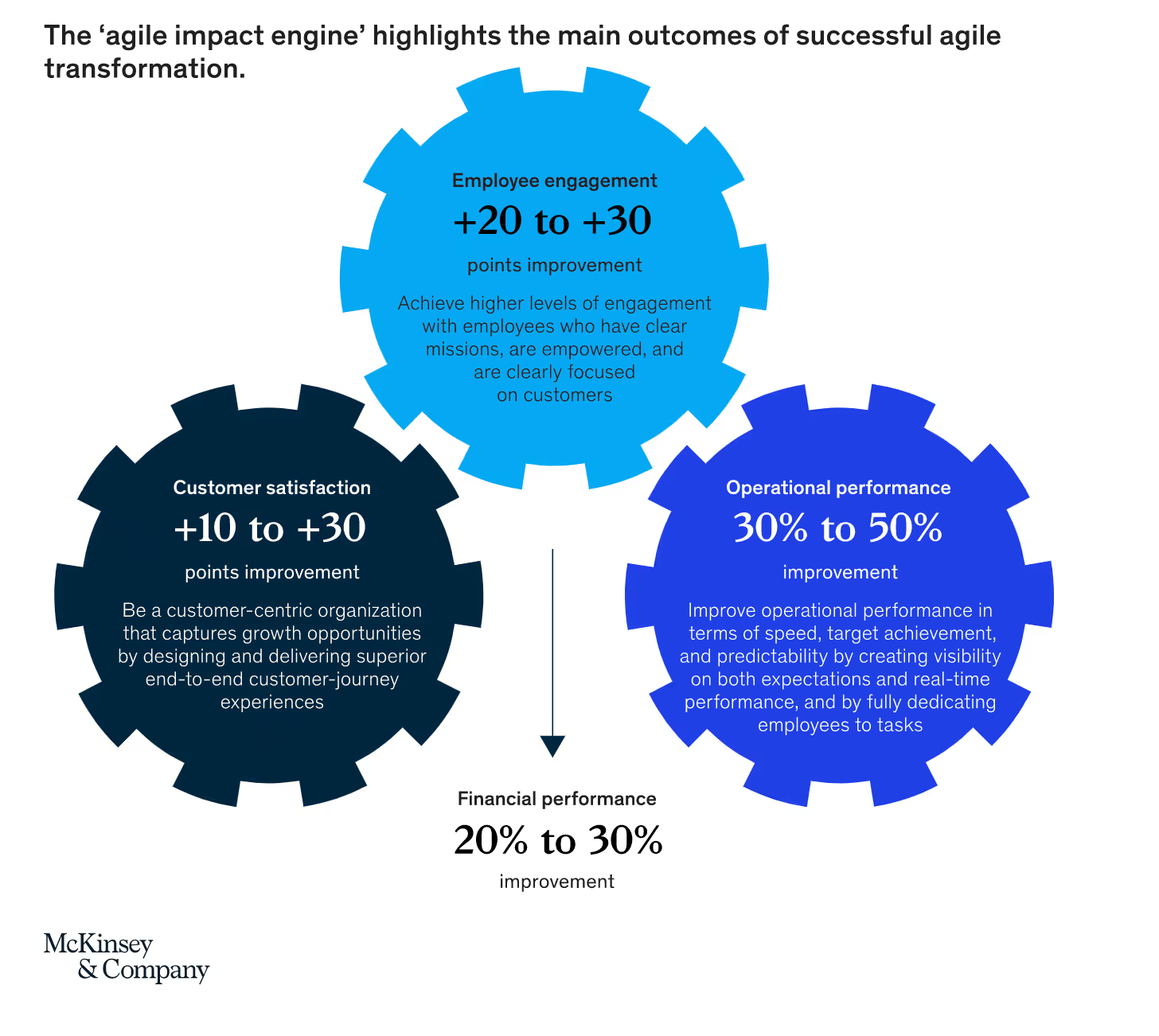

Read Time:
8
Minutes
Digital Transformation
October 14, 2025
Agile Advantages for Business Strategy Success
The historical disconnect between business strategy and development reality, where ambitious visions often clash with the challenges of practical implementation has plagued software development for decades. Agile methodologies, particularly Scrum, have emerged as a powerful tool to bridge this gap by promoting iterative development, continuous feedback and collaboration.
Agile methodologies, encompassing various frameworks like Scrum, Kanban and Lean, emphasise flexibility and adaptability. These methodologies prioritise breaking down projects into shorter, time-boxed cycles called Sprints, typically lasting one to four weeks. Each Sprint focuses on delivering a specific set of features, functionalities, or user stories, enabling the continuous delivery of working software. This iterative approach allows for early feedback and course correction from stakeholders and users, ensuring projects stay aligned with business needs and evolving priorities. Additionally, Agile principles like empiricism, which emphasises relying on concrete evidence and data, guide decision-making based on tangible results from user testing, code reviews and performance metrics rather than assumptions (Doshi, H. 2016). This data-driven approach fosters informed decision-making and helps mitigate the risk of project deviations from strategic goals.
Scrum, a specific Agile framework, championed by Ntegra, implements these principles in a structured way. It defines key roles like the Product Owner, responsible for prioritising features based on business goals and user needs, and the Scrum Master, who facilitates communication, removes roadblocks and ensures smooth running of Sprints. Scrum Teams, consisting of developers, designers, architects and testers, work collaboratively within Sprints using techniques like user story mapping, task boards and daily stand-up meetings. These techniques are practised by Ntegra’s Delivery Teams to promote transparency, encourage open communication and foster a shared understanding of project objectives. Since implementing Scrum, our DeliveryTeams have seen significant performance efficiencies, helping our developers to translate strategic vision into tangible features that often exceed client expectations resulting in greater project success rates.
At Ntegra, we prioritise creating a collaborative environment that allows for a deeper understanding of business needs and stakeholder requirements. This is empowered through our Digital Start service offering: a personalised discovery programme initiated prior to delivery to help establish clear direction on realistic deliverables within a timeframe. We prioritise stakeholder buy-in and offer defined roles and responsibilities for ongoing collaboration between Ntegra and client businesses.
The Agile approach stands in stark contrast to traditional Waterfall or sequential development methods. Waterfall methodologies follow a linear, phase-gated approach where requirements are defined upfront, followed by design, development, testing and deployment in a sequential manner (Royce, W. 1970). This rigid structure often leads to challenges in adapting to the changing tech landscape, stakeholders, perceived business value, requirements or user feedback later in the development lifecycle, potentially causing delays, rework and missed deadlines.
In comparison, Agile and Scrum offer several advantages, especially for distributed teams. The emphasis on short iterations and frequent communication facilitates collaboration even when team members are geographically dispersed. Utilising online collaboration tools like project management platforms, video conferencing and code repositories enables efficient and transparent communication, fostering a sense of shared responsibility. Additionally, the prioritisation of user stories and backlog management ensures that team members are focused on delivering the most critical features first, even if they are in different time zones or regions. At Ntegra, we harness this collaborative approach coupled with focused work management to empower our distributed delivery teams to be highly responsive to evolving business needs and client feedback, fostering faster innovation and delivering value early and often. Find out more about our work.
Companies like IBM and Netflix, renowned for their responsiveness and adaptability, serve as excellent examples of organisations leveraging Agile practices to successfully navigate evolving market demands and deliver innovative products in a distributed work environment. A notable example is Spotify, which has been heralded for its innovative approach to applying Agile principles. The company's model focuses on autonomy and accountability, organising its workforce into "squads" that operate like mini start-ups. This structure has allowed Spotify to innovate at a rapid pace, adapting quickly to user feedback and market changes.
The following image of the ‘Agile impact engine’ is a visualisation of Mckinsey & Co’s preliminary results from their worldwide agile-research effort. They identified three main outcomes of agile transformations: improved customer satisfaction, employee engagement and operational performance.

“The Agile Impact engine forms a framework for assessing potential gains by examining in more depth those organisations that have successfully completed agile transformations.” -McKinsey &Company (2020).
Read the full article for more information.
While there may be many examples of how Agile methodologies can have a substantial and positive impact on various aspects of organisational performance, it is crucial to acknowledge that Agile and Scrum are not without limitations. Implementing Agile requires a cultural shift, potentially leading to initial challenges as teams adapt to new workflows and mindsets. The State of Agile Culture Report (2021) published by Agile Business Consortium revealed that 48% of organisations cite cultural issues as their biggest challenge to successfully implementing Agile. Additionally, while Agile emphasises adaptability, initial planning and backlog creation remain crucial for achieving overall project alignment and ensuring that iterative development stays on track. Lastly, it is important to recognise that Agile might not be the ideal approach for all projects, particularly those requiring strict adherence to pre-defined specifications due to regulations or other constraints.
Nevertheless, this should not be linked to the common misconception that agility and stability are mutually exclusive. In practice, truly agile organisations have debunked this by demonstrating that speed and flexibility can, and often do, coexist with stability and scalability. This is achieved through a dual operating system: one part provides the backbone or stability—the"centre," which ensures efficiency and scalability—while the other fosters dynamic capabilities, enabling rapid response and innovation.
This concept has been discussed in various business articles and literature, including works by management experts like John Kotter and in studies published by the Harvard Business Review. Kotter, for instance, in his work on ‘Leading Change’ (1995), emphasises the importance of having a solid hierarchical structure that provides the 'operating system' for the organisation alongside a more fluid and dynamic network that drives innovation and agility. This resonates deeply with Ntegra’s Innovation Programme - our technology scouting and strategy insights generation engine that we use ourselves and offer to all our strategic partners – Find out more.
Furthermore, McKinsey & Company's research on organisational health and agility highlights how stability—the fixed structures and processes that shape day-to-day operations—is not the enemy but the enabler of agility. This is because certain aspects of stability related to a strong, shared culture or standardised processes can allow employees to react quickly and effectively to new challenges and opportunities.
To delve deeper into how stability supports agility, particularly in large-scale operations, readers can explore Kotter's principles on organisational change and McKinsey's insights on agile transformations, which provide comprehensive frameworks for understanding and achieving this balance.
The effectiveness of Agile methodologies in strengthening business strategy is especially evident in the dynamic landscape of start-ups, where agility is not just beneficial but essential for survival and growth. For start-ups, these methodologies are not just project management tools; they are integral to their operational DNA. They facilitate start-ups in navigating the often turbulent waters of market demands and technological shifts.
Start-ups by their nature, require a mechanism that allows for rapid pivoting as they typically operate with limited resources and under significant market pressure to deliver innovative solutions quickly. Working in Agile caters to this need by fostering an environment where iterative development is the norm, feedback loops are tight and collaboration is a daily routine. This aligns perfectly with the lean start-up methodology that encourages start-ups to develop a minimum viable product (MVP) and then iterate based on user input (Blank, S. 2013). More importantly, as start-ups grow, the principles of Agile and Scrum can scale with them, providing a stable yet flexible framework that supports expansion and the addition of new team members without losing the core focus on delivering customer value quickly and efficiently.
Numerous studies and real-world examples demonstrate their effectiveness in fostering adaptability, improving communication and increasing project success rates. Nevertheless, recognising potential limitations and ensuring the chosen methodology aligns with specific project needs and organisational culture is crucial for successful implementation. In essence, for many businesses trying to keep up in today’s dynamic digital age, Agile and Scrum methodologies are not just about software development; they are about setting a foundation for a business that is responsive, adaptable and driven by customer satisfaction. They allow businesses to evolve their strategies based on actionable insights rather than static plans, positioning them well to become competitive and resilient. Therefore, companies that embrace Agile ways of working, as Ntegra does, are empowered to thrive in a dynamic and competitive global landscape by bridging the gap between business strategy and development reality.
References
1. Aghina, W., Handscomb, C., Ludolph, J., Rona, D. and West, D. (2020). ‘Enterprise Agility: Buzz or Business Impact?’ McKinsey & Company.
2. Agile Business Consortium. (2011). ‘Annual State of Agile Culture Report 2021-22’. Agile Business Consortium
3. Blank, S.G. (2013).‘Why the Lean Start-up Changes Everything’. Harvard Business Review.
4. Digital.ai. (2021).‘14th Annual State of Agile Report’. Digital.ai
5. Doshi, H. (2016).‘The Three Pillars of Empiricism (Scrum)’. Scrum.org
6. Kotter, J.P. (2012). ‘Accelerate!’. Harvard Business Review.
7. McKinsey &Company. (2015). ‘The Keys to Organisational Agility’. McKinsey Publishing.
8. Royce, W. (1970). ‘Managing the Development of Large Software Systems.’ Praxis Framework.
If you enjoyed this blog post, explore these related topics from Ntegra's Blog Hub for deep insights, industry trends, and thought leadership. Our curated content navigates the ever-evolving landscape of technology, innovation, and business strategy.
The Role of the Discovery Phase in Agile Software Development
Product Led Growth is the De Facto Strategy and Operating Model
How Do You Maximise Innovation Within Large Enterprises?
The Benefits of Prototyping and Why You Should Be Doing It
A Deeper Dive into the Evolving Landscape of Cloud Technology
Venture Capital and Corporate Innovation - A Point of View From Mayfield Fund
Why Adoption is as Important as Technology
The Future Of Israel’s Technology Economy
The Story Of The Israel Start-up Nation

